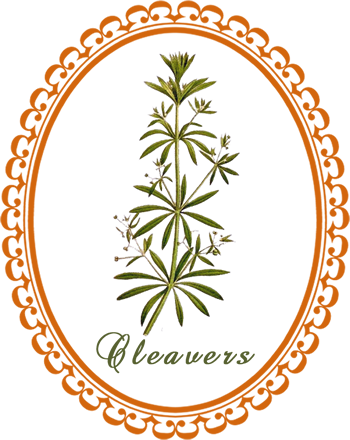
Cleavers is known for its ability to support and cleanse the lymphatic system, particularly where there is an acute "hot" inflammation ...
Common Names: Goose grass, catchstraw, bedstraw, clivers
Botanical Name: Galium aperine
Family: Rubiaceae
Plant Type: Annual climber
Parts Used: The whole herb
Flowering: June to September
Native to Europe and North America, cleavers is found worldwide, and has been found growing as far north as Alaska and Greenland.
Description: Cleavers is a straggling climber whose stems may reach up to five feet. Its narrow leaves can reach 7 cm long and are arranged in whorls of 6-8 around the stem. It clings by the curved hook-like prickles on the four angles of the stems and the edges of the leaves. The entire plant is covered in minute hooked hairs, and can cling to skin, fur and clothing. The flowers are tiny (2mm across), white, 4-petalled tubes. The fruits are purplish green, often borne in clusters of two or three.
Cultivation: Cleavers is a very common hedgerow weed, often found growing in field margins and gardens. It is quick to colonize disturbed ground. This weedy species is an annual that can be grown in temperate regions, in parts of the garden managed for wildlife, as either a summer or winter annual (or occasionally as a biennial). The seed is thought to be viable for around 2-6 years unless frozen. Seeds should be sown in moist soil, preferably a rich loam, with above-average fertility and pH of 5.5-8.0. Seeds must be buried to germinate, ideally at a depth of 2-10 mm. Note that this plant can be invasive. In some parts of the world it is a serious weed of crops and native vegetation, where it can out-compete indigenous species. For this reason, if cultivating cleavers, care should be taken to prevent its spread into farmland or sensitive areas of conservation importance.
Harvesting: Gather in May and June, when it is coming into flower.
Culinary Uses: The whole plant is edible, though not particularly tasty; historically in times of war or famine it has been eaten possibly out of desperation rather than as a delicacy; it is better cooked in soups or as a potherb. Its seeds can be dried and roasted to prepare a sort of coffee substitute.
Herbal Healing with Cleavers
Medicinal Actions: Lymphatic tonic, alterative, diuretic, refrigerant, tonic
Medicinal Uses: With a particular affinity to the lymphatic system, cleavers is indicated in cases of swollen glands - valuable for cases of tonsillitis and adenoid trouble. If infection is present, combine with Echinacea, Calendula or Phytolacca decandra (poke root).
Cleavers will slowly but surely encourage chronically swollen glands (often as a result of repetitive infections that have been treated by antibiotics) to flow freely again. Cleavers is very gentle, and can be taken by children as long as needed.
Cleavers is one of the best-known diuretic herbs for obstructions of the urinary organs; it is particularly effective when combined with uva-ursi, buchu and marshmallow root.
The refrigerant action of cleavers is soothing for both children and adults who are suffering from scalding urine, scarlet fever, measles, and all acute diseases.
Cleavers is a tonic herb, which restores, nourishes and supports the entire body.
Externally - An infusion prepared by macerating 1 1/2 ounces of the herb in 1 pint of warm water for 2 hours can be used in a compress for psoriasis, eczema, scrofula (primary tuberculosis of the lymphatic glands, especially those of the neck), and skin ulcers.
Cautions: There are no known contraindications for taking cleavers, although caution should be used during pregnancy as large doses may affect the uterus. Some people may experience contact dermatitis if the fresh plant comes into direct contact with the skin.
Preparation and Dosage:
Cleavers is most frequently taken as a tincture or a tea.
Tea can be made by steeping 2 to 3 teaspoons in 1 cup of boiling water for ten to fifteen minutes. Drink cold 2 - 4 ounces three or four times a day; may be sweetened with honey or brown sugar.
For tincture, take 20 - 40 drops in water three or four times a day.
If you appreciate the information provided,
please help keep this website running. Blessings!
© 2008-2025 aromaworx.ca. All rights reserved.

